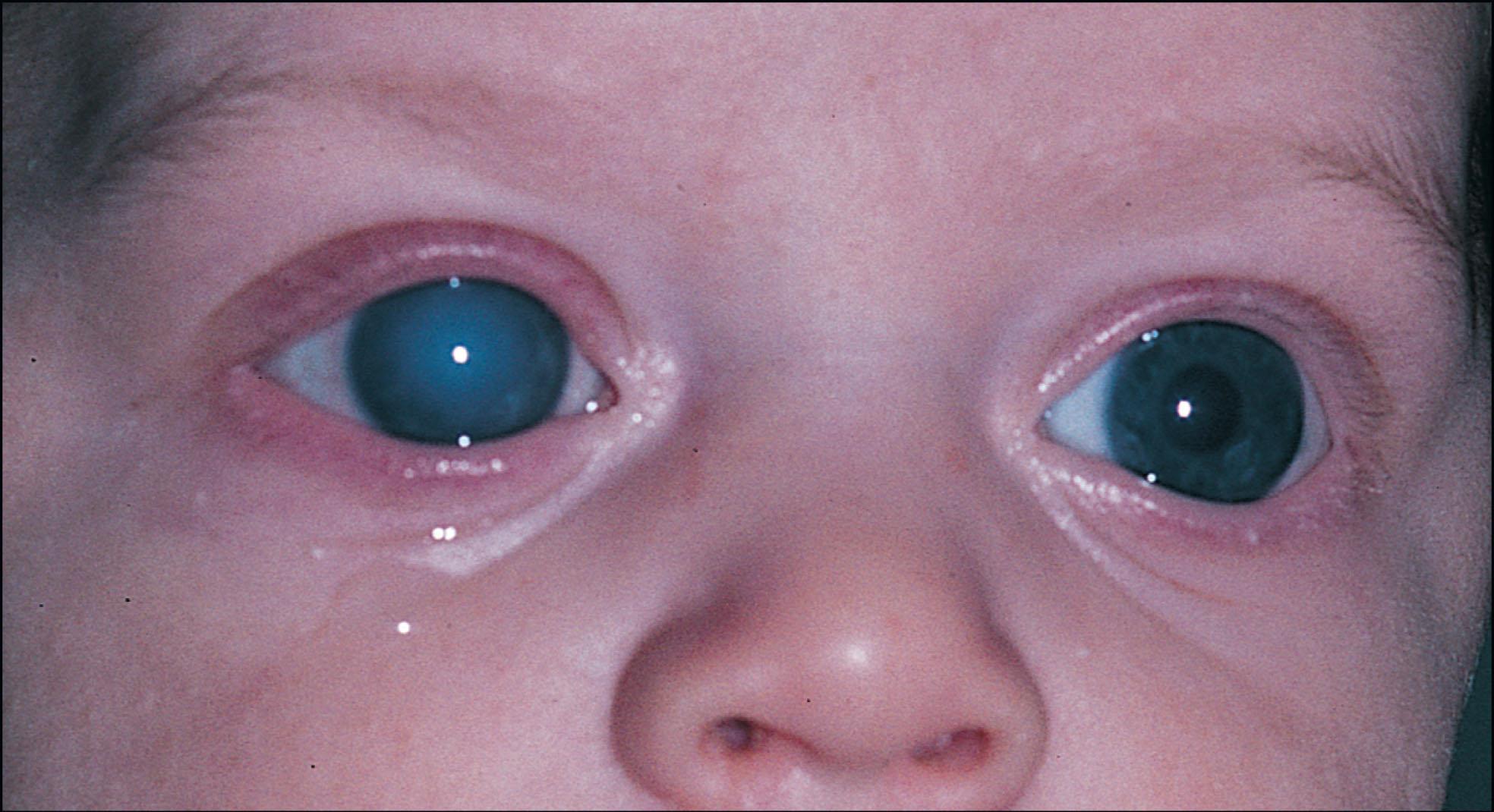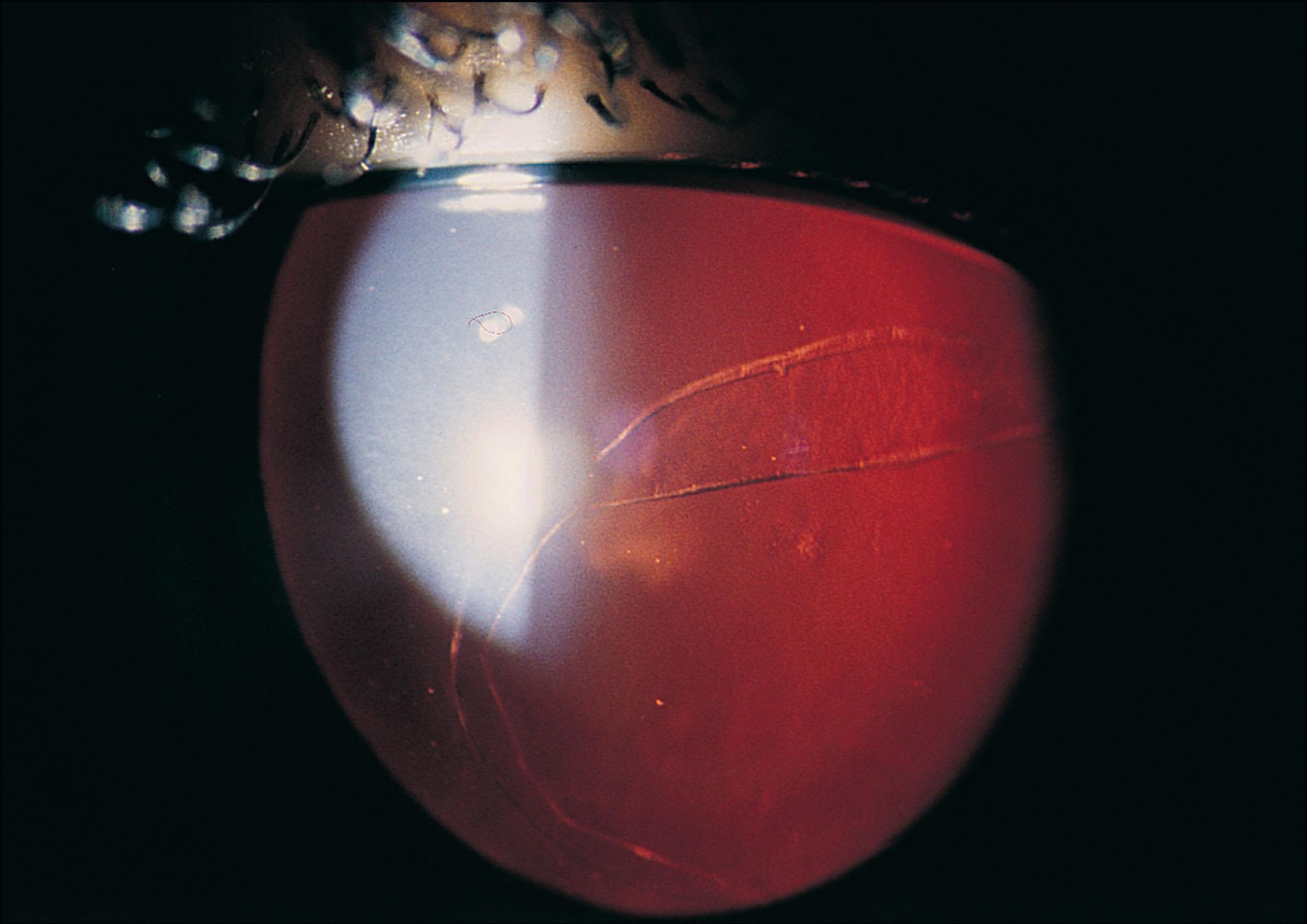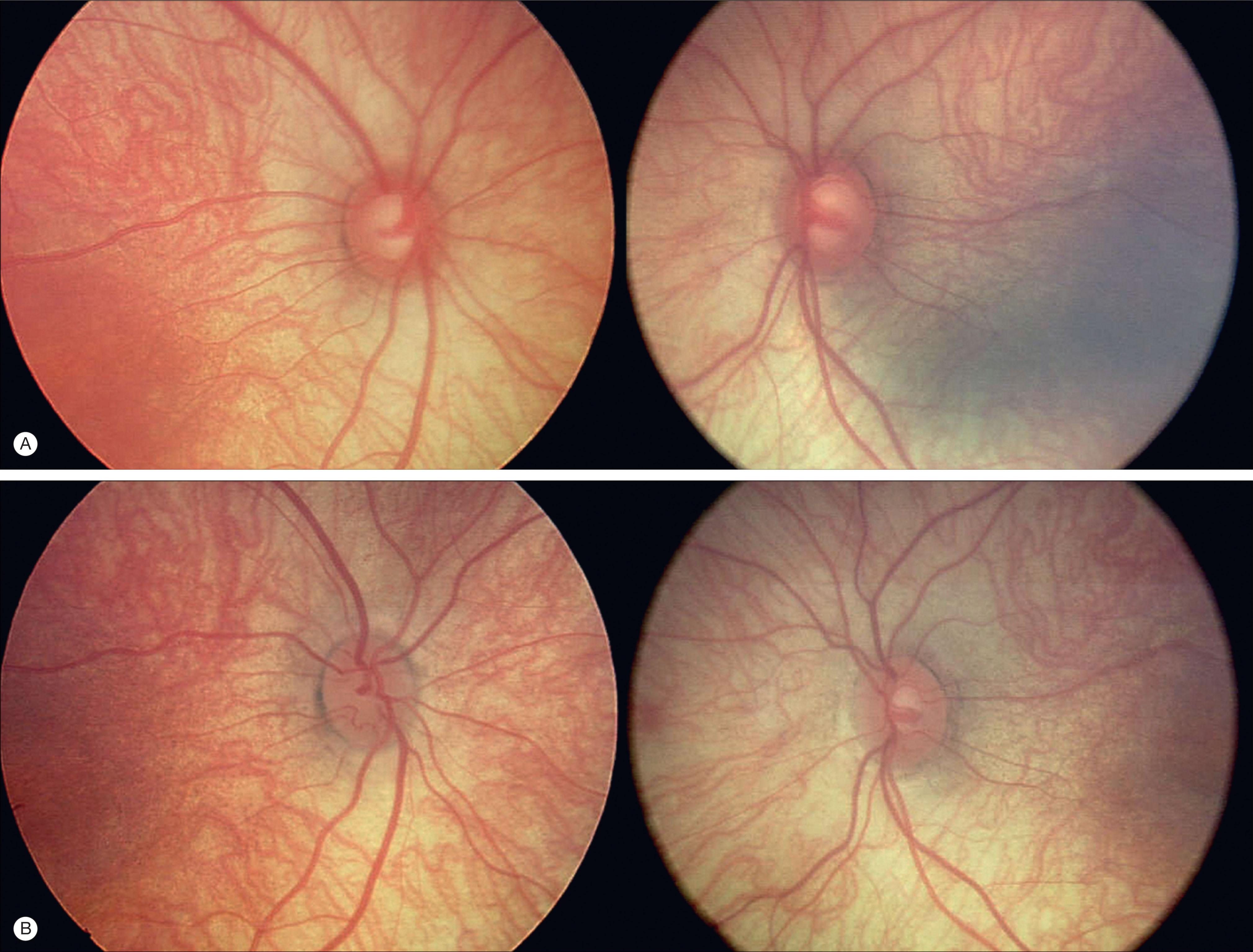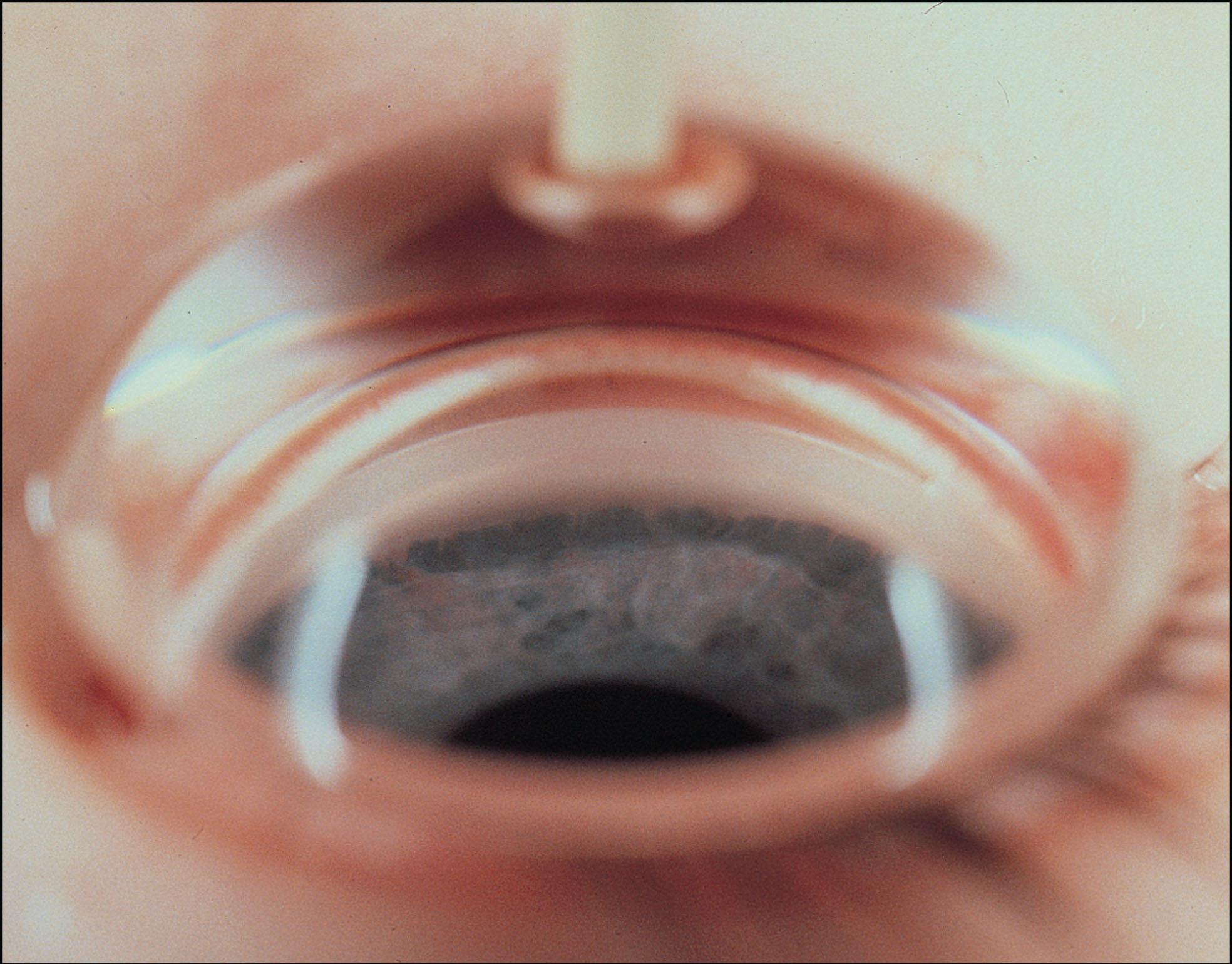Physical Address
304 North Cardinal St.
Dorchester Center, MA 02124
Glaucoma in children less than 2 years of age can be subdivided into (1) primary congenital glaucoma, which is the result of isolated, abnormal development of the anterior chamber angle structures, and (2) secondary congenital glaucoma, either following infantile cataract surgery or those associated with ocular or systemic syndromes.
Elevated intraocular pressure.
Glaucomatous optic atrophy (optic nerve cupping).
Ocular enlargement (“buphthalmos”).
Corneal edema.
Haab’s striae.
Photophobia.
Tearing.
Amblyopia.
Although clinicians commonly group together all the various forms of “congenital” glaucoma, primary congenital glaucoma (PCG) is the term properly reserved for glaucoma arising as a result of an isolated developmental defect of the anterior chamber angle structures. PCG is exceedingly rare, and few ophthalmologists will ever make the initial diagnosis of the disease. On the other hand, most ophthalmologists will encounter the wide variety of secondary glaucomas seen in this age group. In this chapter, the reader is provided with a basic understanding of how the various forms of glaucoma can present in infants and young children, along with their differential diagnosis and treatment options.
The incidence of PCG is between 1 in 10,000 and 1 in 15,000 live births in the United States. Published series range from a low of 1 in 30,000 in Northern Ireland to a high of 1 in 2500 in Saudi Arabia and 1 in 1250 among Roma families in Romania. PCG is bilateral in up to 80%; in North America and Europe, it is more common in boys, whereas in Japan, it is more common in girls. The varied incidence among different populations and the increased incidence in consanguineous populations suggest a strong genetic component. Most new cases (about 90%) of PCG are sporadic. In the remaining 10%, there appears to be a strong familial component; the penetrance of the defect ranges from 40% to 100%.
The pathophysiology and molecular etiology underlying PCG remain elusive in most cases. However, five regions of the genome, termed GLC3A through GLC3E, are strongly associated with the disease. The GLC3A locus (OMIM 231300) harbors the cytochrome P450 1B1 (CYP1B1) gene, in which homozygous or compound heterozygous loss-of-function mutations are the most common cause of autosomal-recessive PCG worldwide, particularly in populations with a high prevalence of consanguinity. CYP1B1 protein is required for normal oxidative homeostasis within the eye, and the loss of its enzymatic activity can result in an abnormal ultrastructural organization and dysfunction of the trabecular meshwork (TM). At the present time, no pathogenic disease-causing mutations have been identified within the GLC3B (OMIM 600975) and GLC3C (OMIM 613085) regions of the genome associated with PCG. At the GLC3D (OMIM 613086) locus, autosomal-recessive PCG disease is caused by homozygous or compound heterozygous loss-of-function mutations in the LTBP2 gene. LTBP2 is an extracellular matrix protein that has roles in cell adhesion and serves as a structural component of microfibrils to confer tissue elasticity. In the eye, LTBP2 protein is localized to the TM and the ciliary body, where it is essential for the normal development of the anterior chamber.
Recently, the dogma that PCG follows an autosomal-recessive inheritance pattern was demonstrated to not always hold true. In approximately 4% of PCG cases, heterozygous loss-of-function mutations in the tunica interna endothelial cell kinase gene encoding TEK (or TIE2 ; OMIM 600221), located within the GLC3E locus (OMIM 617272), were identified as a cause of autosomal-dominant disease. As an animal model of the disease, mice haploinsufficient for TEK were seen to develop a hypomorphic Schlemm’s canal (SC) with a variable number of convolutions and focal narrowings, a hypoplastic TM, and an average 25% rise in intraocular pressure (IOP) compared with control animals. Importantly, the variability in the observed IOP correlated with the severity of SC hypomorphism and provided an explanation for observations in human families where carriers of a TEK mutation were asymptomatic, showed unilateral disease, or developed glaucoma at a later age (e.g., juvenile or primary open-angle glaucoma). The TEK gene encodes a receptor protein that binds extracellular ligands and transduces their signal intracellularly. Mutations in the gene encoding the receptor’s primary agonist, ANGPT1 , have also been identified in a small number of PCG cases. Currently, the molecular basis of disease remains unsolved for approximately 75% of nonconsanguineous PCG families. However, the recent advances in exome and whole-genome sequencing technologies promise to expedite the discovery and characterization of additional PCG-associating genes.
PCG falls within a larger group of disorders involving developmental anomalies of the anterior segment, collectively referred to as anterior segment dysgenesis (ASD; OMIM 107250). These conditions show vast phenotypic and genetic heterogeneity and include variable combinations of congenital abnormalities affecting the iris, cornea, lens, TM, and SC. Consequently, it can be difficult to diagnostically separate PCG from the other ASD disorders when the clinical features outside of the drainage angle are mild. Currently, mutations in PAX6, FOXC1, PITX2, FOXE3, PITX3, PXDN, CPAMD8, B3GLCT , and COL4A1 have been identified in cases of ASD, which may or may not include childhood glaucoma.
In the early 20th century, Barkan postulated that a thin, imperforate membrane covered the anterior chamber angle structures and impeded aqueous humor outflow. This hypothesized structure explained why goniotomy, the operation he developed, was so successful in cases of infantile glaucoma. Barkan’s membrane , as the structure became known, has never been confirmed on light or electron microscopy, despite numerous attempts. Infantile glaucoma is often associated with a broad spectrum of anterior chamber “cleavage” disorders, which suggests that the principal defect in PCG is abnormal development of the anterior chamber angle.
The most common form of secondary glaucoma in young children arises after cataract surgery (glaucoma following cataract surgery [GFCS]) in infancy. The Infant Aphakia Treatment Study reported a 12% incidence of glaucoma-related adverse events at 1 year, which increased to 17% and 22% by 5- and 10-year follow-up, respectively. The underlying cause remains unknown but is almost certainly multifactorial. Risk factors include younger age at cataract extraction, bilateral cataracts, micro cornea, shorter axial length, and undergoing additional procedures after cataract surgery. It remains unknown whether primary intraocular lens implantation (versus aphakia) is protective; however, no difference was seen between these two groups in the Infant Aphakia Treatment Study. Walton examined 65 children, most of whom presented with glaucoma 2 or more years after lensectomy. Preoperative gonioscopy revealed no consistent angle defect, but postoperative gonioscopy revealed a nearly constant (96%) filtration-angle deformity he characterized as blockage of the posterior TM with pigment and synechiae. The presence of both a cataract and a small cornea almost certainly indicates an abnormality that occurred during ocular development; perhaps cataract surgery unmasks a marginally functional and maldeveloped anterior chamber angle and sets the stage for later glaucoma.
Among the secondary glaucomas of childhood, the underlying pathophysiology is as varied as that in adults. Presentation at birth or shortly thereafter indicates a profound developmental abnormality of the anterior chamber angle. Presentation later in life usually suggests a different process. For example, patients with aniridia who present with obvious glaucoma at birth or early childhood have visibly abnormal anterior chamber angle structures, whereas when glaucoma presents later in life in patients with aniridia, the previously functional TM appears occluded by anterior migration and rotation of the rudimentary iris stump. In patients with Sturge–Weber syndrome or its variants, presentation at birth is associated with a gonioscopic appearance of the anterior chamber angle that cannot be differentiated from that of PCG. However, in those patients with glaucoma presenting later in life, elevated episcleral venous pressure is thought to be the cause.
Secondary angle closure may be caused by forward pressure from a process in the posterior segment, such as persistent fetal vasculature, retinopathy of prematurity, or retinoblastoma. Synechial angle closure, caused by chronic inflammation or neovascularization, is seen in a variety of settings. Primary angle closure that results from iris bombé is not generally seen in children except in cases of spherophakia, but when the pupil becomes secluded by an inflammatory or neovascular membrane or vitreous, iris bombé and subsequent angle closure may occur.
Secondary open-angle glaucomas also occur in young children. Both corticosteroid-induced and chronic uveitic glaucomas have been well described. Open-angle glaucoma may develop long after blunt trauma to the eye has occurred and may also follow the spontaneous bleeding of juvenile xanthogranuloma.
The typical infant with congenital glaucoma is usually referred initially to an ophthalmologist because of clinically apparent corneal edema ( Fig. 10.20.1 ). Corneal edema may be subtle—especially in bilateral cases—or may be profound, with an enlarged corneal diameter (buphthalmos) and globe, breaks in Descemet’s membrane (Haab’s striae), and sometimes even acute hydrops. Often the commonly described triad of epiphora, blepharospasm, and photophobia has been present for some time but was dismissed until more alarming corneal edema became apparent. The epiphora of congenital glaucoma is often misattributed to congenital nasolacrimal duct obstruction, which is found in 5%–6% of unselected newborns.

The hallmark of all forms of glaucoma in infants and young children is ocular enlargement, which occurs because the immature and growing collagen that constitutes the cornea and sclera in the young eye responds to increased IOP by stretching. All parts of the globe may stretch in response to elevated IOP until 3 to 4 years of age, and glaucoma-related axial myopia may be seen until the early teen years. Measurement of axial length by ultrasound can be very useful in the diagnosis and monitoring of the pediatric glaucomas, particularly in unilateral or asymmetrical cases. With successful treatment, axial length often returns to a near-normal growth curve.
Clinically, ocular enlargement is most easily discerned by an increase in corneal diameter. Various published series provide some guidelines as to normal measures of corneal diameter; in general, the horizontal corneal diameter in the normal neonate is in the range of 10.0–10.5 mm and increases from 0.5 to 1.0 mm during the first year of life. In an infant in whom glaucoma is suspected, a horizontal corneal diameter of >12 mm gives a high index of suspicion for the disease, as does asymmetry in corneal diameters of more than 1 mm.
As the cornea stretches and distends, Descemet’s membrane and the overlying corneal endothelium may fracture and rip, which results in breaks presenting as profound corneal edema (see Fig. 10.20.1 ) and, in severe cases, acute hydrops. As the endothelial cells migrate over the breaks and lay down new basement membrane, ridges develop along the separated edges of Descemet’s membrane, resulting in the formation of the double striae first recognized by Haab in 1899 ( Fig. 10.20.2 ). In children above 2 years of age, corneal enlargement is usually not the predominant sign that glaucoma is present. In these children, decreased visual acuity or strabismus noted at the pediatrician’s office or progressive unilateral myopia noted in an optometrist’s office typically prompts the referral.

The hallmark of all forms of glaucoma, and the principal cause of irreversible visual loss, is damage to the optic nerve. It is now apparent not only that cupping may occur rapidly in infants but also that this cupping is reversible with surgical treatment and normalization of IOP. Mochizuki et al. described a series of patients in whom a reversal of optic disc cupping was documented with digital photography; planimetry revealed that the scleral canal shrinks in size as the entire globe shrinks circumferentially. Reversibility of optic nerve cupping is one of the hallmarks of successful treatment of glaucoma in infants and young children ( Fig. 10.20.3 ). However, glaucomatous visual field defects and thinning of the retinal nerve fiber layer persist despite cupping reversal. The short-term resilience of the infant optic nerve should be considered by the surgeon who contemplates incisional surgery based only on borderline anterior segment findings; if the optic nerve is normal, a repeat examination under anesthesia in a few weeks may spare the child an unnecessary surgical procedure.

The diagnosis of glaucoma in infants is clinical. In most cases, particularly when the disease presents unilaterally or asymmetrically, the diagnosis is made in the office using a penlight (see Fig. 10.20.1 ). With some practice, IOP can be measured in the office in a conscious, swaddled infant using a Tono-Pen (Reichert Technologies, Depew, NY, USA), handheld Goldmann (Perkins Applanation Tonometer, Haag-Streit UK, Harlow, UK), or iCare Rebound (iCare Finland OY, Vantaa, Finland) tonometer. Usually, the IOP in normal infants is in the range of 11–14 mm Hg (1.5–1.9 kPa) using these devices. The office measurement of an IOP greater than 20 mm Hg (2.7 kPa) in a calm, resting infant is suspicious for glaucoma when other signs and symptoms suggest the disease, as is an asymmetry of more than 5 mm Hg (6.7 kPa) in suspected unilateral or asymmetrical cases. Measurements of IOP undertaken while a child cries and resists efforts to hold the eye open are highly unreliable because the Valsalva maneuver and lid squeezing can result in IOP readings of 30–40 mm Hg (4.0–5.3 kPa), even in normal infants. In toddlers and older children, the iCare Rebound tonometer can be helpful in evaluating IOP and avoiding general anesthesia, but the device tends toward slightly higher values than Goldmann tonometry. The recent recognition that central corneal thickness (CCT) can be an important confounder of accurate tonometry has led to investigations of CCT in children. Variations in CCT may actually represent additional aspects of certain pediatric glaucoma syndromes, such as aniridia. The growing realization that tonometry is far less accurate in adults and children than previously appreciated underscores that the diagnosis of glaucoma in children should not be made solely on the basis of IOP measurement but on a constellation of findings. In addition, parents can learn to take accurate IOP measurements at home using iCare Rebound tonometry.
Examination of the optic nerve is attempted whenever possible because the presence of obvious glaucomatous cupping confirms the diagnosis. A cup-to-disc (C/D) ratio of greater than 0.3 and asymmetry in the C/D ratio between the two optic nerves—especially when the asymmetry corresponds with other findings—is strongly suggestive of glaucoma. The optic nerve may also be monitored using optical coherence tomography (OCT) measurements of the retinal nerve fiber layer, and normative values in children have been found to be comparable to those in young adults.
A Koeppe infant diagnostic lens that does not have a central depression employs a lid-retention flange to prevent the infant from squeezing out the contact lens. Once in place, good visualization of the disc is possible using a direct ophthalmoscope, even with a relatively small pupil. With dilation, fundus photography to document the appearance of the optic nerve may be possible. With a Koeppe diagnostic infant lens in place, gonioscopy may be performed, even in a conscious infant in the office. Simultaneous gonioscopy of both eyes may be carried out to compare the angle appearance in unilateral or asymmetrical cases. The diagnosis of glaucoma is not made using gonioscopic appearance alone but is based primarily on the other signs and symptoms of the disease. However, gonioscopy may help differentiate among the various forms of glaucoma and, most importantly, provide the surgeon with an idea of whether angle surgery (goniotomy or trabeculotomy) or fistulization surgery (trabeculectomy or drainage implant) should be the first intervention. The gonioscopic appearance of the anterior chamber angle in PCG is characteristic ( Fig. 10.20.4 ); the iris inserts anteriorly compared with the normal infant angle. The stroma of the peripheral iris is hypoplastic and unpigmented and has a scalloped appearance. Anterior segment OCT has also been used to visualize Schlemm’s canal in patients with primary congenital glaucoma, and abnormal tissue over the angle has been found among several patients. This abnormal tissue over the angle has been postulated to represent Barkan’s membrane and has also been observed using high-frequency ultrasound biomicroscopy.

If the diagnosis of glaucoma is confirmed or strongly suspected based on the office examination, an examination under anesthesia (EUA) and definitive surgical treatment are pursued within a few days. Serial EUAs may be needed to monitor young children in whom only a limited exam can be performed in the clinic. However, the increased tolerability of iCare Rebound tonometry can reduce the number of EUAs needed for IOP monitoring. Details on the EUA, as well as goniotomy and trabeculotomy, are provided in Chapter 10.25 .
As noted previously, some forms of PCG represent heritable disorders, as do many of the secondary or systemically associated glaucomas of childhood. All children who have glaucoma that presents at birth and in early childhood should be referred to a clinical geneticist familiar with ocular disease. In some cases, a subtle syndromic diagnosis may be made that has important implications for the parents’ future childbearing plans. Furthermore, the variable expressivity observed among CYP1B1 mutations means that the siblings of affected children should be tested as well. If the same mutation is found in the clinically as-yet unaffected sibling, that child must be followed carefully. Because of advances in the molecular diagnosis of some forms of PCG, it is now possible to offer prenatal screening for some families.
Become a Clinical Tree membership for Full access and enjoy Unlimited articles
If you are a member. Log in here